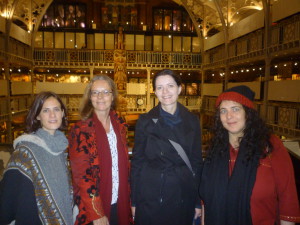On October 18th the team took part in a workshop, with the aim of studying Inner Asian material culture in connection with three different forms of exchange: trade, religion and knowledge.
The invited speaker was Isabelle Charleux, a leading expert on the history of art and architecture of Inner Asia, from the thirteenth to the twenty-first century. Her research interests focus on Mongol material culture at the Chinese frontiers, Mongol Buddhist art and pilgrimages, Buddhist architecture in Mongol society, the visual representation of past and present ancestors and figures of authority in the Mongol world, and the interactions between Mongol, Tibetan and Chinese Buddhism(s) in China.

At the morning session, led by Dr Charleux and Dr Lyce Jankowski Sackler (Fellow in Chinese Numismatics at Worcester College and the Ashmolean Museum of Art and Archaeology), we discussed the concept of “Silk Road”, first coined by a German geographer in the nineteenth century, and today widely used. As a result of this discussion we all agreed on the fact that historians and archaeologists need to revisit this notion – a collective task for the Nomadic empires team members. Dr Jankowski guided us through the Ashmolean galleries, highlighting the most interesting items of the collection. We focused on the means of exchange in Eurasia, between the Tang period and the Ming period, such as coins, lingua Franca, and knowledge transfer (especially metal craft, food and medicine). We ended our session on the question of maps and ways of mapping routes across Eurasia. We discussed more specifically a range of trade itineraries, human migrations and pilgrimages – a topic on which Dr Charleux has crucial expertise.
The afternoon session was led by Dr Charleux and focused on power representations in Inner Asia. She opened the session on the symbols of power used by the Mongol khans. These symbols were linked to Tengri (Sky), the cult of the ancestors and Buddhism. We looked at the terminology connected to the act of worshipping in Mongolian: sülde (vital force), onggon (shrines containing relics or portraits), qara sülde, tsagan sülde (black and white standards). We discussed the various aspects of the worship of the black and white standards in the Ordos (today’s inner Mongolia, China). The white standard is still the symbol of the Mongol nation. We compared the Mongol native notion of Tengri/ Sky-God and the imperial Mandate of Heaven under the Chinese and the Türks. Then we studied a wide range of effigies of Chinggis Khan (two dimensional portraits, statues), we listed their political and religious uses and looked at their development from the thirteenth to the twenty-first century. We tried to date the shift from the original cult of the ancestors to the personal cult of Chinggis Khan. Finally we examined the late development of this cult under the influence of Buddhism and in connection with the rising political role of the Dalai-Lama.